Inheritance with EF Code First: Part 2 – Table per Type (TPT)
|
In the previous blog post you saw that there are three different approaches to representing an inheritance hierarchy and I explained Table per Hierarchy (TPH) as the default mapping strategy in EF Code First. We argued that the disadvantages of TPH may be too serious for our design since it results in denormalized schemas that can become a major burden in the long run. In today’s blog post we are going to learn about Table per Type (TPT) as another inheritance mapping strategy and we'll see that TPT doesn’t expose us to this problem. Table per Type (TPT)Table per Type is about representing inheritance relationships as relational foreign key associations. Every class/subclass that declares persistent properties—including abstract classes—has its own table. The table for subclasses contains columns only for each noninherited property (each property declared by the subclass itself) along with a primary key that is also a foreign key of the base class table. This approach is shown in the following figure: |
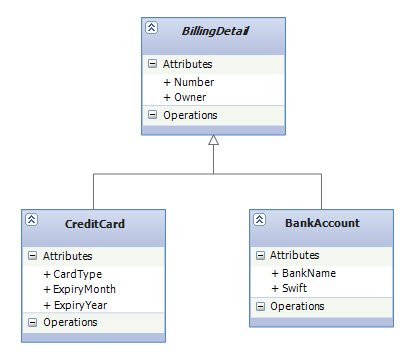 |
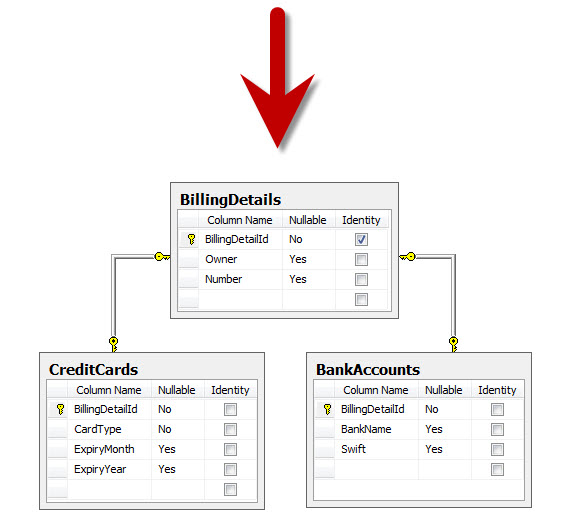 |
For example, if an instance of the CreditCard subclass is made persistent, the values of properties declared by the BillingDetail base class are persisted to a new row of the BillingDetails table. Only the values of properties declared by the subclass (i.e. CreditCard) are persisted to a new row of the CreditCards table. The two rows are linked together by their shared primary key value. Later, the subclass instance may be retrieved from the database by joining the subclass table with the base class table.
TPT AdvantagesThe primary advantage of this strategy is that the SQL schema is normalized. In addition, schema evolution is straightforward (modifying the base class or adding a new subclass is just a matter of modify/add one table). Integrity constraint definition are also straightforward (note how CardType in CreditCards table is now a non-nullable column). Implement TPT in EF Code FirstWe can create a TPT mapping simply by placing Table attribute on the subclasses to specify the mapped table name (Table attribute is a new data annotation and has been added toSystem.ComponentModel.DataAnnotations namespace in CTP5): |
public abstract class BillingDetail |
| If you prefer fluent API, then you can create a TPT mapping by using ToTable() method: |
protected override void OnModelCreating(DbModelBuilder modelBuilder) |
Polymorphic AssociationsA polymorphic association is an association to a base class, hence to all classes in the hierarchy with dynamic resolution of the concrete class at runtime. For example, consider the BillingInfo property of User in the following domain model. It references one particular BillingDetail object, which at runtime can be any concrete instance of that class. |
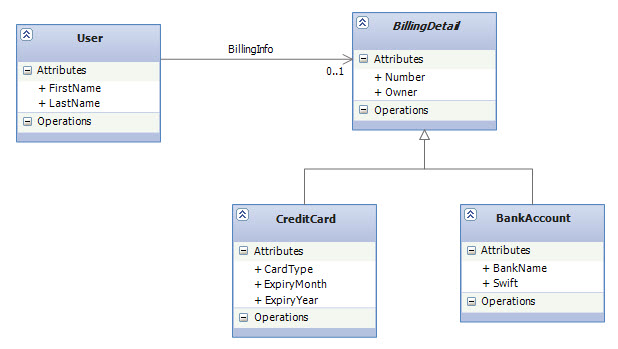 |
In fact, because BillingDetail is abstract, the association must refer to an instance of one of its subclasses only—CreditCard or BankAccount—at runtime.
Implement Polymorphic Associations with EF Code FirstWe don’t have to do anything special to enable polymorphic associations in EF Code First; The user needs a unidirectional association to some BillingDetails, which can be CreditCard or BankAccount so we just create this association and it would be naturally polymorphic: |
public class User |
| In other words, as you can see above, a polymorphic association is an association that may refer instances of a subclass of the class that was explicitly specified as the type of the navigation property (e.g. User.BillingInfo).
The following code demonstrates the creation of an association to an instance of the CreditCard subclass: |
using (var context = new InheritanceMappingContext()) |
| Now, if we navigate the association in a second context, EF Code First automatically retrieves the CreditCard instance: |
using (var context = new InheritanceMappingContext()) |
Polymorphic Associations with TPTAnother important advantage of TPT is the ability to handle polymorphic associations. In the database a polymorphic association to a particular base class will be represented as a foreign key referencing the table of that particular base class. (e.g. Users table has a foreign key that references BillingDetails table.) |
Generated SQL For QueriesLet’s take an example of a simple non-polymorphic query that returns a list of all the BankAccounts: |
var query = from b in context.BillingDetails.OfType<BankAccount>() select b; |
| Executing this query (by invoking ToList() method) results in the following SQL statements being sent to the database (on the bottom, you can also see the result of executing the generated query in SQL Server Management Studio): |
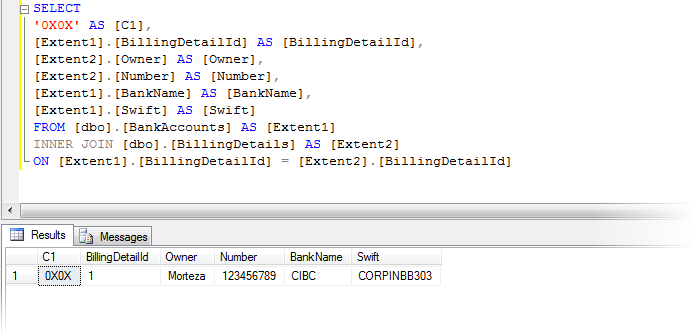 |
| Now, let’s take an example of a very simple polymorphic query that requests all the BillingDetails which includes both BankAccount and CreditCard types: |
var query = from b in context.BillingDetails select b; |
| This LINQ query seems even more simple than the previous one but the resulting SQL query is not as simple as you might expect: |
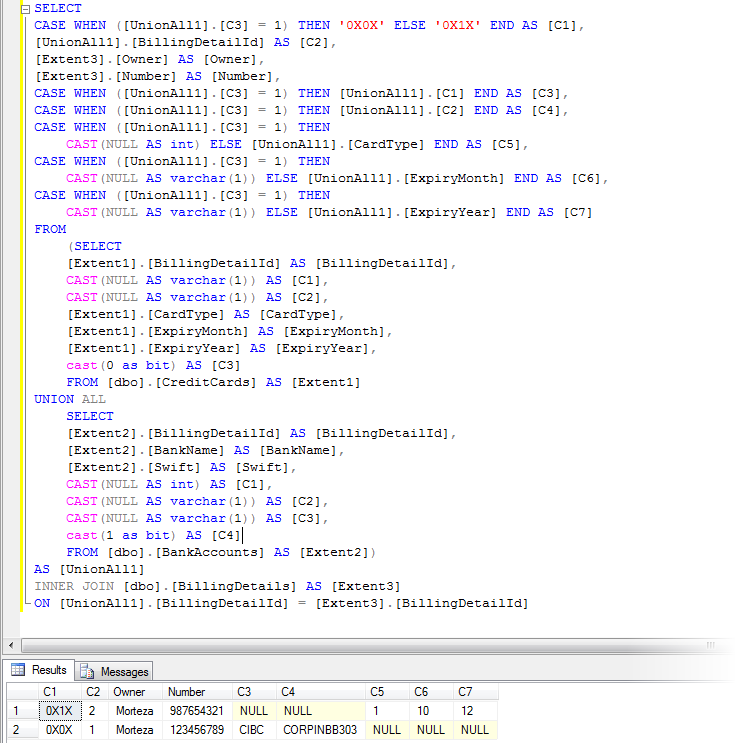 |
As you can see, EF Code First relies on an INNER JOIN to detect the existence (or absence) of rows in the subclass tables CreditCards and BankAccounts so it can determine the concrete subclass for a particular row of the BillingDetails table. Also the SQL CASE statements that you see in the beginning of the query is just to ensure columns that are irrelevant for a particular row have NULL values in the returning flattened table. (e.g. BankName for a row that represents a CreditCard type)
TPT ConsiderationsEven though this mapping strategy is deceptively simple, the experience shows that performance can be unacceptable for complex class hierarchies because queries always require a join across many tables. In addition, this mapping strategy is more difficult to implement by hand— even ad-hoc reporting is more complex. This is an important consideration if you plan to use handwritten SQL in your application (For ad hoc reporting, database views provide a way to offset the complexity of the TPT strategy. A view may be used to transform the table-per-type model into the much simpler table-per-hierarchy model.) |
SummaryIn this post we learned about Table per Type as the second inheritance mapping in our series. So far, the strategies we’ve discussed require extra consideration with regard to the SQL schema (e.g. in TPT, foreign keys are needed). This situation changes with the Table per Concrete Type (TPC) that we will discuss in the next post. |
原文地址:http://weblogs.asp.net/manavi/inheritance-mapping-strategies-with-entity-framework-code-first-ctp5-part-2-table-per-type-tpt
Inheritance with EF Code First: Part 2 – Table per Type (TPT)的更多相关文章
- Inheritance with EF Code First: Part 3 – Table per Concrete Type (TPC)
Inheritance with EF Code First: Part 3 – Table per Concrete Type (TPC) This is the third (and last) ...
- Inheritance with EF Code First: Part 1 – Table per Hierarchy (TPH)
以下三篇文章是Entity Framework Code-First系列中第七回:Entity Framework Code-First(7):Inheritance Strategy 提到的三篇.这 ...
- EF Code First学习系列
EF Model First在实际工作中基本用不到,前段时间学了一下,大概的了解一下.现在开始学习Code First这种方式.这也是在实际工作中用到最多的方式. 下面先给出一些目录: 1.什么是Co ...
- 1.什么是Code First(EF Code First 系列)
EF4.1中开始支持Code First .这种方式在领域设计模式中非常有用.使用Code First模式,你可以专注于领域设计,根据需要,为你一个领域的对象创建类集合,而不是首先来设计数据库,然后来 ...
- 从零开始,搭建博客系统MVC5+EF6搭建框架(1),EF Code frist、实现泛型数据仓储以及业务逻辑
前言 从上篇30岁找份程序员的工作(伪程序员的独白),文章开始,我说过我要用我自学的技术,来搭建一个博客系统,也希望大家给点意见,另外我很感谢博客园的各位朋友们,对我那篇算是自我阶段总结文章 ...
- IoC容器Autofac - Autofac + Asp.net MVC + EF Code First(转载)
转载地址:http://www.cnblogs.com/JustRun1983/archive/2013/03/28/2981645.html 有修改 Autofac通过Controller默认构造 ...
- MVC项目实践,在三层架构下实现SportsStore-01,EF Code First建模、DAL层等
SportsStore是<精通ASP.NET MVC3框架(第三版)>中演示的MVC项目,在该项目中涵盖了MVC的众多方面,包括:使用DI容器.URL优化.导航.分页.购物车.订单.产品管 ...
- EF Code First 学习笔记:表映射
多个实体映射到一张表 Code First允许将多个实体映射到同一张表上,实体必须遵循如下规则: 实体必须是一对一关系 实体必须共享一个公共键 观察下面两个实体: public class Perso ...
- EF Code First一对一、一对多、多对多关联关系配置
1.EF Code First一对一关联关系 项目结构图: 实体类: Account.cs using System; using System.Collections.Generic; using ...
随机推荐
- C++中头文件、源文件之间的区别与联系
.h头文件和.cpp文件的区别 疑惑1:.h文件能够编写main函数吗? 实验: 编写test.h文件,里面包含main函数 若直接编译g++ test.h -o test,通过file命令 file ...
- css3 flex布局/grid布局
1.CSS3 Flexbox 布局完全指南(图解 Flexbox 布局详细教程) 2.CSS Grid 布局完全指南(图解 Grid 详细教程)
- Genymotion的使用 -- A Faster Android Emulator
Genymotion 安装与配置 1,Genymotion 模拟器 EditText获取焦点时不自动弹出软件盘 选择该模拟器的设置--> 选中Use Virtual keyboard for t ...
- 使用自定义端口连接SQL Server 2008的方法
版权声明:本文为博主原创文章,未经博主允许不得转载. 使用过SQL Server的人大多都知道,SQL Server服务器默认监听的端口号是1433,但是我今天遇到的问题是我的机器上有三个数据库实例, ...
- bzoj 3027 [Ceoi2004]Sweet——生成函数
题目:https://www.lydsy.com/JudgeOnline/problem.php?id=3027 化式子到 ( \mul_{i=1}^{n}(1-x^(m[i]+1)) ) / (1- ...
- [转载]PCI/PCIe基础——配置空间
转载地址:http://blog.csdn.net/jiangwei0512/article/details/51603525 PCI/PCIe设备有自己的独立地址空间,这部分空间会映射到整个系统的地 ...
- Mybatis-Spring包学习
MyBatis-Spring包用来将MyBatis无缝整合到Spring中.使用这个类库中的类, Spring将会加载必要的MyBatis工厂类和Session类. 这个类库也提供一个简单的方式来注入 ...
- Java基础--阻塞队列ArrayBlockingQueue
ArrayBlockingQueue是阻塞队列的一种,基于数组实现,长度固定,队尾添加,队首获取, 构造函数: ArrayBlockingQueue(int capacity) ArrayBlocki ...
- (转)nodejs搭建本地http服务器
本文转载自:http://www.cnblogs.com/shawn-xie/archive/2013/06/06/3121173.html 由于不做php相关的东西,懒得装apache,干脆利用no ...
- 深入VR之前 你应该知道VR头显透镜原理
转自:http://www.gamelook.com.cn/2016/03/246817 要理解虚拟现实头显透镜的工作原理,首先要搞懂眼睛是如何看到事物的. 眼睛瞳孔后有晶状体,也就是眼珠子.眼睛的背 ...
